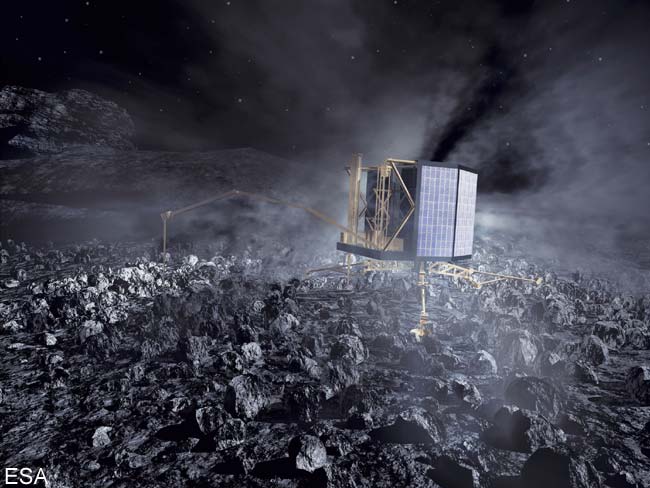
A European spacecraft chasing a distant comet has caught sight of its quarry just before entering a planned 31-month slumber in deep space.
The European Space Agency's Rosetta spacecraft has been chasing the comet 67-P/Churyumov-Gerasimenko for more than seven years. In the last few weeks, Rosetta snapped its first images of the comet, ESA officials announced this month.
Rosetta took a series of 52 pictures from a distance of about 101 million miles (163 million kilometers) from comet 67-P/Churyumov-Gerasimenko. Because of the vast distance, the comet appears as a single point of light. [See Rosetta's first comet photo]
"But the pictures already give us a good idea of where we are headed," Holger Sierks of the Max Planck Institute for Solar System Research, lead investigator for Rosetta's camera system, said in a June 8 statement. "In addition, they are a remarkable proof of the camera's performance. We had not expected to be able to create first images from so far away."
Mission scientists will have to wait a while for their second glimpse of 67-P/Churyumov-Gerasimenko, or to hear anything else from Rosetta. The spacecraft went into a deep slumber on June 8, shutting down all of its instruments and most of its control systems. Only its computer and several heaters remain on.
The hibernation period is no glitch. It was planned to help Rosetta save energy on its long cruise to the comet. The probe is so far from the sun — 341 million miles (549 million km) as of June 8 — that solar energy is tough to come by.
Rosetta will rouse itself automatically in January 2014, to prepare for its rendezvous with 67-P/Churyumov-Gerasimenko in July of that year, researchers said. [Best Close Encounters of the Comet Kind]
Breaking space news, the latest updates on rocket launches, skywatching events and more!
Chasing down a comet
The $1.4 billion Rosetta mission launched in March 2004. When it arrives at 67-P/Churyumov-Gerasimenko, it will initiate a long-term, up-close study of the comet. Rosetta will orbit the icy wanderer for about 18 months, and it will drop a small lander called Philae onto the comet's surface.

Comets are among the most primitive objects in the solar system, so researchers hope Rosetta's observations can help them reconstruct the early history of our cosmic neighborhood. The mission will also look for organic molecules on 67-P/Churyumov-Gerasimenko's surface, to investigate the possibility that a long-ago comet strike could have seeded Earth with the building blocks of life.
67-P/Churyumov-Gerasimenko is about 2.4 miles (4 km) across and completes one orbit around the sun every 6.6 years.
Rosetta has been doing some science on its long journey to the comet. In 2008, for example, it made a close flyby of the asteroid Steins. And last year, it swung by the asteroid Lutetia, giving astronomers an unprecedented look at the 62-mile-wide (100-km) space rock.
Going to sleep
At 4 a.m. EDT (0800 GMT) on June 8, Rosetta automatically started spinning, which will stabilize the probe while its normal attitude control system is off throughout hibernation, ESA officials said. About five hours later, the final shutdown command was sent, and radio contact was lost with the probe, as expected.
So now the mission team will wait until Jan. 20, 2014, when a timer will wake Rosetta and spur it to send a signal back to Earth for the first time 2 1/2 years.
"Hibernation is a necessary step to reach the final target," said Paolo Ferri, head of the Solar and Planetary Mission Operations Division at ESA's Space Operations Centre. "We are now looking forward to 2014, when Rosetta becomes the first spacecraft to track the life of a comet as it arcs in toward the sun."
You can follow SPACE.com senior writer Mike Wall on Twitter: @michaeldwall. Follow SPACE.com for the latest in space science and exploration news on Twitter @Spacedotcom and on Facebook.
Join our Space Forums to keep talking space on the latest missions, night sky and more! And if you have a news tip, correction or comment, let us know at: community@space.com.

Michael Wall is a Senior Space Writer with Space.com and joined the team in 2010. He primarily covers exoplanets, spaceflight and military space, but has been known to dabble in the space art beat. His book about the search for alien life, "Out There," was published on Nov. 13, 2018. Before becoming a science writer, Michael worked as a herpetologist and wildlife biologist. He has a Ph.D. in evolutionary biology from the University of Sydney, Australia, a bachelor's degree from the University of Arizona, and a graduate certificate in science writing from the University of California, Santa Cruz. To find out what his latest project is, you can follow Michael on Twitter.
